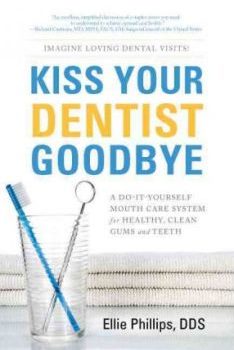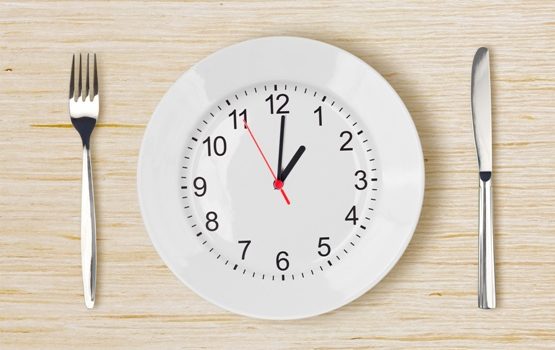
Kiss Your Dentist Goodbye – Ellie Phillips
(Buy from Amazon; Buy from The Book Depository)
You brush, floss, use mouthwashes, and are concerned about the foods you eat, yet you still require fillings or lengthy cleanings at the dentist. In Kiss Your Dentist Goodbye, Dr. Ellie Phillips teaches how anyone can achieve and maintain a truly healthy mouth. Empower yourself as you improve the look and feel of your teeth between dental visits. Your dentist will be amazed at the changes he sees, and you will be thrilled as cavities and gum disease become a thing of the past. Traditional dentistry cannot prevent dental disease. But Ellie’s do-it-yourself daily routine can. Discover how easy it is to reduce plaque buildup, strengthen tooth enamel, repair small cavities, eliminate tooth sensitivity, and improve your overall oral health. Learn about products that hinder your efforts and the risks of bleaching, dental sealants and the wrong use of fluoride. It is time to achieve healthy, clean teeth and gums and wow your dentist at the next appointment.
Praise for Kiss Your Dentist Goodbye:
”An excellent, simplified discussion of complex issues you need to understand to achieve optimal oral health.”
–Richard Carmona, MD, MPH, FACS, 17th surgeon general of the United States
”This book, despite its intriguing title, does not denigrate dentists. What it really does is tell readers how best to work with dentists to achieve true preventative care.”
–Milton B. Lederman, PhD, retired director of public aff airs, University of Rochester Medical Center; co-author of Co-existing with Cancer
”As a dentist, the title of this book is shocking! But the information in the book is vital to anyone who wants to minimize dental problems, maximize dental health, and enjoy their smile for a lifetime.”
–Corky Willhite, DDS; fellow, American Academy of Cosmetic Dentistry
Disclaimer: This page contains affiliate links that may provide monetary compensation to help support the Whole Guidance Vision of Creating a Happy and Healthy Planet should you make a purchase. We very much appreciate and thank you for your support.

“The light of the world will illuminate within you when you fast and purify yourself.”
— Mahatma Gandhi
Like most people I was taught that breakfast is the most important meal of the day and skipping it was a bad idea. Without breakfast you get tired later in the day, you cannot focus or think clearly, your hunger grows, and you will get health issues including weight gain, metabolic diseases, and malnutrition.
With this is in mind I grew up eating cereal with milk or toast with hot chocolate for breakfast and I did this every single morning for decades.
However, after learning about holistic, functional, and ancestral health practises and applying these to my life in order to overcome personal health challenges, my breakfast ritual has changed dramatically where I no longer eat breakfast till late in the day and some days I don’t eat at all.
CLICK HERE TO LEARN WHAT ARE THE MOST NUTRIENT DENSE REAL FOODS
This is called intermittent fasting (IF) where you fast for a certain period of time and then eat within a specific time window and what I’ll be exploring in this article.
A typical fast differs from IF as it lasts for a prolonged period of time, usually several days or a few weeks, without eating food and usually involves drinking only water during the fast, aka a water fast.
Why would you intentionally starve yourself? Well it is during times of fasting that your body can perform critical maintenance and repair functions that cannot be executed when in a fed or un-fasted state.
Benefits to Fasting
- Resets growth, appetite, stress, and sex hormones to healthy levels
- Switches your body to burn fat rather than sugar as fuel
- Increases human growth hormone production
- Reduces inflammation and oxidative stress
- Normalises HDL, LDL, and triglyceride levels
- Promotes healthier body composition
- Supports body’s innate ability to heal from sickness and disease
- Improves cognitive function including learning, memory, and focus
- Elevates energy (yes, more energy by not eating!)
- Less time cooking, cleaning, and more time working on your goals
Most of these benefits come from a process called autophagy. During autophagy each of your cells seek out all the junk, microbes, and other toxins within the cell and recycle them into new building blocks for the cell. Whatever is leftover or unusable gets excreted as waste.
If you eat frequently and don’t give your body enough time to switch on autophagy and recycle the trash then this junk and your risk of infection grows and grows and grows causing many health issues.
Imagine if you never took the trash out of your house or if the garbage truck never showed up for weeks. Not only would your house begin to fill up with rubbish leaving you no space to move, work, and play, but you’d also get flies, maggots, and bugs taking over your home, and of course don’t forget about the smell!
This is what’s happening when you eat all the time and don’t have a long enough period without food. It is when you fast for periods of at least 12 hours that your cells have time to switch on the autophagy process and clear out the trash, the toxins, and the harmful microorganisms.
Just as it’s easier for you to move and think in an organised house or office space, after autophagy your cells become more efficient and more effective at running metabolic processes giving you more energy and clarity of thought.
Am I saying you should go on a strict water fast for days on end to get even more energy and health benefits? No, as there is a tipping point to where your cells will begin to become malnourished and your body switches to a state of hibernation and stasis. A prolonged water fast is definitely an option to consider though, if you are dealing with a chronic health condition.
A general guideline is the more metabolically deranged you are or to use the more acceptable term, if you have metabolic syndrome, the longer the fast should be. For example a water fast of 3-14 days under medical supervision would suit people with obesity, high blood pressure, high triglycerides, high blood sugar, or high amounts of small LDL cholesterol particles.
A smarter and more sustainable way to fast for anyone looking to improve and maintain health and performance markers is to experiment with intermittent fasting, with set periods of fasting and feeding and being able to change these feeding windows to suit your individual goals. You get all the benefits of going on a prolonged water fast, without having to do an actual water fast.
Before I give my recommended IF protocols there are certain groups of people that should not do any kind of fasting:
- Children
- Pregnant/breastfeeding women
- People with cortisol dysregulation (chronic stress)
- Severely underweight individuals
If you fall into one of these categories undergoing an IF protocol has the potential to cause more stress to your body than it can handle.
Types of Intermittent Fasting
Here is a list of intermittent fasting protocols you can play with in order of difficulty (the difficulty of any change in diet comes down to your personal perception of the diet and the changes that you need to make, so as with anything in life your mileage may vary).
12:12 (Fast window 12 hours, Feed window 12 hours)
This is a daily fast lasting 12 hours leaving the other 12 hours to eat. During the fast you can have water (optionally with lemon juice or apple cider vinegar), black coffee, and teas without nothing added.
This is the most natural and easiest to stick to out of all the IF protocols.
I recommend finishing your last meal by 8p at the latest and not eating till 8a in the morning. For example, if you finished your last meal at 6p, you wouldn’t eat your first meal until around 6a the next day.
16:8 (Fast window 16 hours, Feed window 8 hours)
Similar to 12:12, but with a 16 hour daily fast with an eight hour eating window. During the fast you can have water (optionally with lemon juice or apple cider vinegar), black coffee, and teas with nothing added.
Personally I find 16:8 to be the simplest way to eat and is my go-to IF protocol for getting quick results in terms of changing body composition and reducing the waistline.
Again I recommend finishing your last meal by 8p at the latest and not eating until 12p. For example, if you finished your last meat at 6p you wouldn’t eat your first meal until around 10a.
The Fast Diet / The 5:2 Diet (Feed window 5 days, Fast window 2 days)
With the Fast Diet you eat normally for five days of the week and then fast for two days. The two fasting days can be in a row or split up during the week.
During the two fasting days you are allowed to eat up to 500-600 calories anytime during the day.
Eat-STOP-Eat (Feed window 5/6 days, Fast window 1 or 2 days)
Another weekly IF protocol involving eating normally for five or six days and fasting for one or two days a week. During the fast you can have water, black coffee, and teas with nothing added.
The Warrior Diet (Fast both morning and afternoon, Feast evening)
This diet involves eating like some of our ancestors where you fast during the day and feast on your ‘hunt’ during the evening.
During the day as well as black coffee and teas with nothing added, you can have a high quality whey protein shake, but only post high intensity resistance or sprint training. Also berries and non-starchy vegetables are okay to eat during your fast.
In the evening is when you eat one large meal to satisfy your hunger.
Alternate Day (Fast window every other day)
Eat normally one day; eat nothing the next.
During the fasting day you can have water, black coffee, and teas with nothing added.
Note Well
It should not have to be said, but I’ll say it anyway – with all of these IF protocols food quality is the key to success. Eat real food and make those calories you eat as nutrient dense as possible.
Also with any dietary protocol remember you don’t have to be strict. You must experiment with each and find what works for you and make it your own or move on to something else.
For example I’ve settled on using the Warrior diet as a template. My IF protocol is my own type of Warrior diet where I have two cups of coffee and cream/ghee with a little whey powder in the morning, drink a lot of water (one with ACV) throughout the day, and then have one big meal in the evening full of vegetables and some meat or fish.
For more information about how to use fasting to heal I highly recommend the book The Complete Guide to Fasting by Dr Jason Fung and Jimmy Moore.
Two other books that incorporate IF into a holistic healthy lifestyle are The Wild Diet by Abel James and The Bulletproof Diet by Dave Asprey.
Summary
Yes breakfast is still the most important meal of the day… to skip! It is the timing, when you break your fast, that makes breakfast the most important meal of the day.
Breakfast doesn’t have to be at the beginning of the day. Remember breakfast means to break a fast or simply the first meal of the day. You can skip breakfast or fast for the entire day – this is called intermittent fasting.
By implementing an intermittent fasting protocol you will improve your health and gain extra time in your day to get after your dreams.
